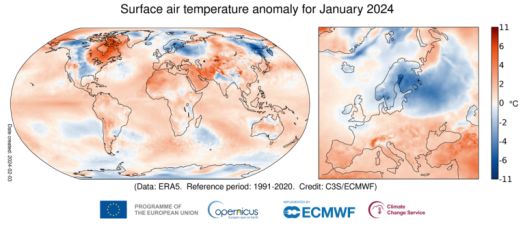The record-breaking trend seen for much of 2023 has continued in 2024, with January being the hottest January on record. It is the eighth month in a row that is the warmest on record for the respective time of the year. Sea surface temperatures have been record high for ten consecutive months.
This is according to the US National Oceanic and Atmospheric Administration (NOAA), NASA, the European Union’s Copernicus Climate Change Service and Japan Meteorological Agency. These are four of the six international datasets which feed into WMO’s State of the Climate reports.
The average monthly surface air temperature was 1.66°C warmer than an estimate of the January average for 1850-1900, the designated pre-industrial reference period. This is according to the ERA5 dataset used by the Copernicus Climate Change Service (C3S), which is implemented by the European Centre for Medium-Range Weather Forecasts on behalf of the European Commission.
This does not mean that the world has exceeded the lower-level target of 1.5° Celsius above the pre-industrial era referred to in the Paris Agreement on Climate Change. The Paris Agreement refers to long-term warming over many years rather than monthly or annual exceedances.
It was 0.70°C above the 1991-2020 average for January and 0.12°C above the temperature of the previous warmest January, in 2020, according to Copernicus Climate Change Service.

Unprecedented Warmth: The data reveals January 2024 as the warmest month on record globally, highlighting a stark deviation from the 30-year average. This map visualizes the significant temperature anomalies that contribute to this record-breaking warmth, signaling a clear and concerning trend in our planet's climate trajectory.
Data: ERA5. Reference period: 1991-2020. Credit: C3S/ECMWF
Global precipitation was nearly record-high in January, following on the heels of a record-wet December. Large portions of North America, Asia and Australia were wetter than average, whereas much of southern Africa and South America were drier than normal. The El Niño rainfall pattern over the central and western Pacific Ocean weakened, but patterns over Africa and the southern United States remained more typical of El Niño, according to the monthly NOAA report.
El Niño began to weaken in the equatorial Pacific, but marine air temperatures in general remained at an unusually high level, according to Copernicus Climate Change Service.
The average global sea surface temperature for January over 60°S–60°N reached 20.97°C, a record for January, 0.26°C warmer than the previous warmest January (2016), and second highest value for any month in the ERA5 dataset, within 0.01°C of the record from August 2023 (20.98°C).
Since 31 January, the daily sea surface temperature for 60°S–60°N has reached new absolute records, surpassing the previous highest values from 23rd and 24th of August 2023.
The final WMO State of the Global Climate 2023 report will be published for World Meteorological Day on 23 March 2024. WMO has already confirmed that 2023 was by far the warmest year on record due to human-induced climate change and a warming El Niño.

January 2024: A Month of Climate Extremes - From record-breaking global temperatures to significant sea ice shifts, our planet continues to showcase dramatic signs of climate change.
NOAA
Refer
https://wmo.int/media/news/world-had-warmest-january-record
Related Products
 Tel:+86-156-1892-2826 Email:info@healthyphoton.com
Add:Room 305, Building 1, Zhongchuang Science Park, Jinyuan Road, Panhuo Street, Yinzhou District, Ningbo City,China
Tel:+86-156-1892-2826 Email:info@healthyphoton.com
Add:Room 305, Building 1, Zhongchuang Science Park, Jinyuan Road, Panhuo Street, Yinzhou District, Ningbo City,China


